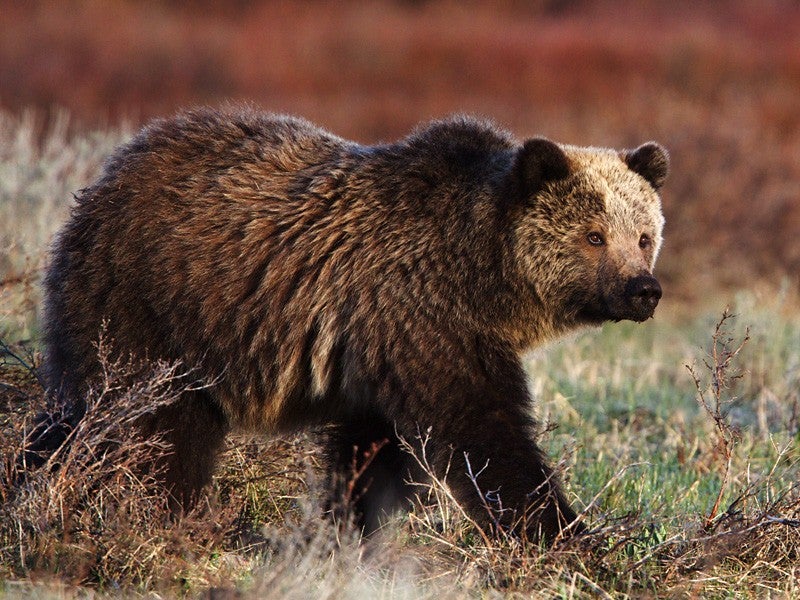Judge Rules Feds Erred in Approving Killing of Four Protected Grizzly Bears in Grand Teton National Park
Victory
—Ruling concludes agencies violated the Endangered Species Act
Contact
A federal court ruled that government officials acted illegally in authorizing the killing of four grizzly bears, a threatened species, within one of the nation’s premiere national parks: Grand Teton National Park in northwest Wyoming.
The 310,000-acre Grand Teton National Park serves as a vital sanctuary for many species.
The ruling by U.S. District Judge Rudolph Contreras concluded that the U.S. Fish and Wildlife Service and National Park Service violated the Endangered Species Act in September 2013 when they decided to allow the lethal “taking” of four grizzly bears in connection with a fall elk hunt in Grand Teton National Park. The court agreed with three conservation groups—the Sierra Club, Western Watersheds Project, and Center for Biological Diversity—that federal officials wrongfully disregarded the cumulative impact of the four grizzly killings allowed in Grand Teton together with 63 other grizzly bear “takings” that federal biologists have authorized around the Yellowstone region.
“Federal wildlife officials have been handing out exemptions allowing the killing of the Yellowstone region’s iconic grizzly bears with very little scrutiny—and with no scrutiny whatsoever of the cumulative harm caused by mounting grizzly mortalities over the past few years,” said Earthjustice attorney Timothy Preso, who represented the groups in the lawsuit. “This decision should put a stop to that.”
“This important court ruling confirms that the Fish and Wildlife Service cannot cut corners in analyzing the impacts of federally sanctioned actions on our country’s endangered species,” said Andrea Santarsiere, a staff attorney with the Center for Biological Diversity. “Grand Teton National Park should be a safe haven for grizzly bears, not a killing zone.”
“Unfortunately, the Fish and Wildlife Service has made it a habit of doing the same thing this court has ruled as illegal,” said Jonathan Ratner of the Western Watershed Project. “Nearly all the grizzly bear biological opinions issued by the FWS in the Greater Yellowstone Ecosystem suffer from the same violation of the ESA.”
Bonnie Rice, with Sierra Club’s Our Wild America in the Yellowstone region, added, “The Fish and Wildlife Service has repeatedly increased authorization of grizzly bear killing in the Yellowstone region, while ignoring the big picture effects on this vulnerable population. Upping the ‘take’ without requiring stringent measures to reduce conflicts between grizzly bears and hunters in one of our nation’s most iconic national parks is particularly irresponsible for an agency charged with protection of threatened species.”
BACKGROUND
Yellowstone-area grizzly bears are listed as a threatened species under the Endangered Species Act. Federal biologists acknowledge that population growth of the Yellowstone grizzly bear has flattened over the past decade. Prior to and during that same period, the grizzly population has been faced with the loss of two of its most important food sources in the Yellowstone region—whitebark pine seeds and cutthroat trout—due to changing environmental conditions driven in part by a warming climate. In the wake of these changes, scientists have documented the bears’ transition to a more meat-based diet, but that diet leads to a greater potential for conflict with humans.
The federal authorization for killing four grizzly bears in Grand Teton National Park came in the wake of a Thanksgiving Day 2012 elk hunt, in which three hunters shot and killed an adult male grizzly bear. Anticipating more such conflicts as the region’s grizzlies turn to meat-based food sources such as hunter-killed or wounded elk, federal officials in September 2013 approved the killing of four more grizzly bears in connection with future elk hunts in Grand Teton through the year 2022.
The conservation groups’ lawsuit, which was filed in April 2015, faulted the Fish and Wildlife Service and National Park Service for ignoring a mounting level of grizzly mortality and its implications for the recovery of the Yellowstone-area population in authorizing the killing of four more grizzly bears in Grand Teton National Park. The killing of these four grizzlies, when added to the other grizzly “taking” previously authorized by government biologists around the Yellowstone region, could triple the amount of loss that is considered to be sustainable. Nevertheless, the government never took that “big picture” look at grizzly mortality. Today’s court decision rules that the government’s conduct violated the Endangered Species Act and sends the Fish and Wildlife Service back to the drawing board to reexamine the cumulative “takings” issue.
The ruling comes in the wake of the Fish and Wildlife Service’s proposal on March 11, 2016 to remove the Yellowstone region’s grizzlies from the protections of the Endangered Species Act. The Service is taking public comment on this proposal until May 10, 2016.

Additional Resources
About Earthjustice
Earthjustice is the premier nonprofit environmental law organization. We wield the power of law and the strength of partnership to protect people's health, to preserve magnificent places and wildlife, to advance clean energy, and to combat climate change. We are here because the earth needs a good lawyer.